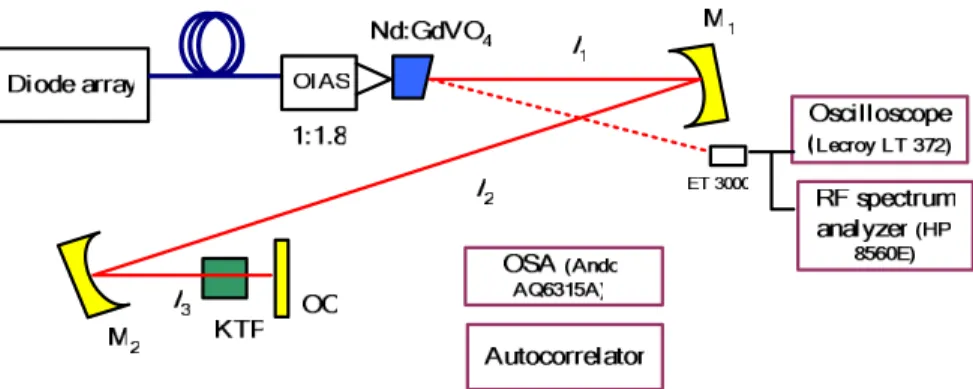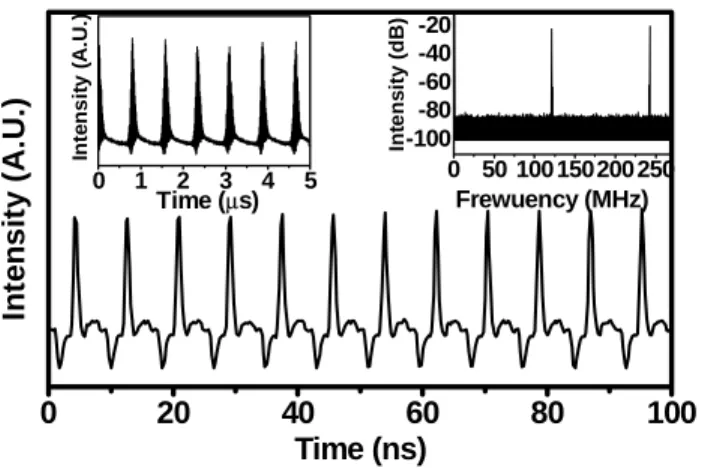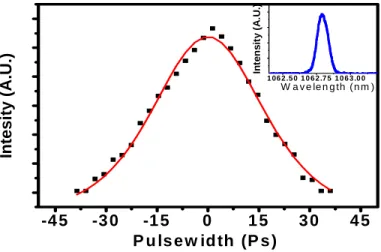Low threshold and high power output of a
diode-pumped nonlinear mirror mode-locked
Nd:GdVO
4
laser
Ja-Hon Lin, Wen-Hsun Yang, and Wen-Feng Hsieh Department of Photonics & Institute of Electro-Optical Engineering
National Chiao Tung University, 1001 Tahsueh Rd., Hsinchu wfhsieh@mail.nctu.edu.tw
Kuei-Huei Lin
Department of Applied Physics, National University of Kaohsiung, 700 Kaohsiung University Road, Kaohsiung, Taiwan 811
Abstract: We demonstrated nonlinear mirror mode-locking of a
diode-pumped Nd:GdVO4 laser by using a 10 mm long KTP crystal. The
stable CW mode locking can be reached with the relative low threshold pump power as low as 2.3W. The highest output power of 2.65W at the 10 W pump powers are generated with the 121-MHz repetition rate of pulses. It confirms the excellent laser performance of the Nd:GdVO4 for high-peak
power of the pulse operation.
©2005 Optical Society of America
OCIS codes: (140.4050) Mode locked laser; (140.3580) Lasers, solid state; (140.3480) Lasers,
diode pumped; (190.0190) Nonlinear optics
References and Links
1.H. D. Jiang, H. J. Zhang, J. Y. Wang, H. R. Xia, X. B. Hu, B. Teng, C. Q. Zhang, “Optical and laser properties of Nd:GdVO4 crystal,“ Opt. Commun. 198, 447 (2001).
2.J. Kong, D. Y. Tang, S. P. Ng, B. Zhao, L. J. Qin, X. L. Meng, “Diode-pumped passively mode-locked Nd : GdVO4 laser with a GaAs saturable absorber mirror,” Appl. Phys. B-Lasers and Optics 79, 203 (2004). 3.S. Zhang, E Wu, H. Pan, and H. Zeng, “Q-switched mode-locking with Cr4+:YAG in a diode pumped
Nd :GdVO4 laser,” Appl. Phys. B-Lasers and Optics 78, 335 (2004).
4.L. Krainer, D. Nodop, G. J. Spühler, S. Lecomte, M. Golling, and R. Paschotta, D. Ebling, T. Ohgoh and T. Hayakawa, K. J. Weingarten, U. Keller, “Compact 10-GHz Nd:GdVO4 laser with 0.5-W average output power and low timing jitter," Opt. Lett. 29, 2629 (2004).
5. S. Zhang, E Wu, H. Pan, and H. Zeng, “Passive mode locking in a diode-pumped Nd:GdVO4 laser with a semiconductor saturable absorber mirror,” IEEE J. Quantum. Electron. 40, 505 (2004).
6.H Pan, S. Xu and H. Zeng, “Passively Q-switched single-longitudinal-mode c-cut Nd:GdVO4 laser with a twisted-mode cavity,” Opt. Express 13, 2755 (2005),
http://www.opticsexpress.org/abstract.cfm?URI=OPEX-13-7-2755.
7.J.-H Lin, M.-D. Wei, and W.-F. Hsieh, H.-H. Wu, “Cavity configurations for soft-aperture Kerr-lens mode locking and multiple-period bifurcations in Ti:sapphire lasers,” J. Opt. Soc. Am. B 18, 1069 (2001). 8.K. A. Stankov, “A mirror with an intensity-dependent reflection coefficient,” Appl. Phys. B 45, 191 (1988). 9.G. Cerullo, M. B. Danailov, S. De Silvestri, P. Laporta, V. Magni, D. Segala, and S. Taccheo, “A
diode-pumped nonlinear mirror mode-locked Nd:YAG laser,” Appl. Phys. Lett. 65, 2392 (1994). 10. A. A. Mani, Ph. Hollander, P. A. Thiry, and A. Peremans, “All-solid-state 12 ps actively passively
mode-locked pulsed Nd:YAG laser using a nonlinear mirror,” Appl. Phys. Lett. 75, 3066 (1999). 11. P. K. Datta, S. Mukhopadhyay, S. K. Das, L. Tartara, A. Agnesi, and V. Degiorgio, “Enhancement of
stability and efficiency of a nonlinear mirror mode-locked Nd:YVO4 oscillator by an active Q-switch,” Opt. Express 12, 4041 (2004), http://www.opticsexpress.org/abstract.cfm?URI=OPEX-12-17-4041.
12. P. K. Datta, S. Mukhopadhyay, and A. Agnesi, “Stability regime study of a nonlinear mirror mode-locked laser,” Opt. Commun. 230, 411 (2004).
13. Y. F. Chen, S. W. Tsai, S. C. Wang, “High-power diode-pumped nonlinear mirror mode-locked Nd:YVO4 laser with periodically-poled KTP,” Appl. Phys. B-Laser and Optics 72, 395 (2001).
14. A. Agnesi, C. Pennacchio, and G. C. Reali, V. Kubecek, “High-power diode-pumped picosecond Nd3+:YVO
4 laser,” Opt. Lett. 22, 1645 (1997).
15. J.-H. Lin, W.-H. Yang, and W.-F. Hsieh, “Nonlinear mirror mode-locked Nd:GdVO4 laser with splitting
double pulses”, presented at the International Conference on Quantum Electronics 2005 and the Pacific Rim Conference on Lasers and Electro-Optics 2005 (IQEC/CLEO-PR 2005), Tokyo, 11-15, July (2005). 16. C. Honninger, R. Paschotta, F. Morier-Genoud, M. Moser, and U. Keller, “Q-switching stability limits of
continuous-wave passive mode locking,” J. Opt. Soc. Am. B 16, 46 (1999).
17. S. J. Holmgren, V. Pasiskevicius, and F. Laurell, “Generation of 2.8 ps pulses by mode-locking a Nd:GdVO4 laser with defocusing cascaded Kerr lensing in periodically poled KTP,” Opt. Express 11, 5270 (2005), http://www.opticsexpress.org/abstract.cfm?URI=OPEX-13-14-5270.
18. W. Koechner, Solid-state laser engineering, fifth ed., (Springer, Berlin, 1999) Chap. 10.
1. Introduction
All solid-state diode-pumped Nd3+ doped picosecond lasers have attracted much attention in various applications such as optical communication, nonlinear optical spectroscopy, optical frequency conversion, microsurgery, and biomedicine. Among the Nd3+ doped crystals, Nd:GdVO4 has become of great interest due to its good optical and mechanical properties.
The relatively broader gain bandwidth and the unexpectedly higher thermal conductivity of Nd:GdVO4 than Nd:YVO4 makes it favorable for mode-locking with much narrower pulse
duration to provide the desirable high-peak power [1].
Intra-cavity saturable absorbers [2, 3] and semiconductor saturable absorber mirrors (SESAM) [4-6] have recently been used for passively mode-locking of Nd:GdVO4 laser.
For generating shorter or femtosecond pulse trains [7], artificial fast satruable absorber utilizing the inherent optical Kerr nonlinearity or self-focusing of the laser crystal has been widely used to self-mode-locked solid-state lasers. However, it is more problematic for Kerr-lens mode-locking of picosecond lasers due to their low peak intensity, which in turn lead to weak nonlinear modulation. The nonlinear mirror mode locking (NLM-ML) provides strong nonlinear loss modulation that was first proposed by Stankov [8]. The NLM-ML consists of a nonlinear crystal placed in front of the output coupler of the laser cavity. The output coupler (OC) provides 100% reflection for the second harmonic wave (SHW) and partial reflection for the fundamental wave (FW). If the SHW experiences an appropriate phase shift with respect to the FW before the second pass through the nonlinear crystal, then the reflected SHW may be completely converted back to the FW. This process acts as a fast saturable absorber, which can compress the FW laser pulse due to less loss (higher conversion into the SHW) in the central part of pulse than the leading and trailing edges at the dichroic OC.
NLM-ML has been experimentally demonstrated in Nd:YAG [9-10] and Nd:YVO4
[11-14] lasers using various nonlinear crystals, including KTP, PPKTP, and LBO. Recently, we have reported the splitting double pulses in the NLM-ML of the Nd:GdVO4 laser in the
In this paper, NLM-ML of diode-pumped Nd:GdVO4 laser has been achieved by using a
10-mm-long type-II KTP crystal and a OC of 80% reflectivity for the FW. Relatively lower threshold pump power and higher output power for the stable CML are demonstrated in our Nd:GdVO4 laser.
2. Experiments
The schematic figure-Z laser setup is shown in Fig. 1. A 4x4x8 mm3 a-cut Nd:GdVO4
crystal (with 0.5% Nd3+ concentration) is end-pumped by a fiber-coupled laser diode array (FAP-81-16C-800-I, Coherent Inc.) at 808 nm. The pump beam coming out from the fiber is imaged on the crystal through the 1:1.8 optical imaging accessories (OIA’s, Coherent Inc.). Therefore, the radius of the pump beam (Wp) in the gain medium is about 225 μm, which is
slightly larger than the estimated radius of the cavity mode (Wg) at the gain medium (about
210 μm by using the ABCD law and considering the thermal lensing effect in the Nd:GdVO4
crystal). The laser crystal and KTP was wrapped with indium foil and mounted in a water-cooled copper block where the water temperature was maintained at 15 °C. One side of the Nd:GdVO4 crystal is high-reflection (HR) coated at 1064 nm and anti-reflection (AR)
coated at 808 nm pumping wavelength. The other side of the crystal with 2° wedge is AR coated at 1064 nm. The laser cavity consists of two concave mirrors M1 (the radius of
curvature, R= 500 mm) and M2 (R = 200 mm), and a dichroic OC with reflectivity of 80% at
1064 nm and high reflectivity at 532 nm. The total length of the laser is 123 cm, with l1 =
30.5 cm (the distance from the laser crystal to M1), l2 = 80.5 cm (the distance between two
curved mirrors M1 and M2), and l3 = 11 cm (the distance from M2 to OC). A 10-mm-long
type-II KTP crystal was antireflection-coated at both end faces for wavelengths of 1064 nm and 532 nm and was placed very close to the dichroic OC for SH generation.
The output power of the Nd:GdVO4 laser were measured by a power meter (Scientech
365) for both CW and ML states. We used the beam analyzer (WinCamD) to observe the output beam pattern. The leakage radiation reflected from the wedged facet of the laser crystal was detected by a high speed InGaAs detector (Electro-Physics Technology ET 3000) that was connected to the oscilloscope (LeCroy LT372, bandwidth 500MHz) and the RF spectrum analyzer (Hewlett Packard 8560E). A noncollinear autocorrelator with the 1-mm thick type-I BBO, and an optical spectrum analyzer (Ando-AQ6315A) with resolution of 0.01 nm were placed outside the OC to measure the puleswidth and optical spectrum. According to the theory of NLM-ML proposed by Stankov [8], a phase change of -π between FW and SHW is needed before the second pass through the nonlinear crystal. Therefore, we adjusted the phase by changing the distance between the nonlinear crystal and the dichroic mirror, which resulted in the dispersion of FW and SHW in the air medium to get the back conversion. Initially, the flashing green light was observed to signal the onset of the nonlinear mode coupling. After slightly detuning the location of KTP, CML pulse trains with linearly polarized and the pure TEM00 output mode with radius about 1.5 mm can be
obtained. By further changing the distance between KTP and OC slightly, the phenomena of multiple pulsing and harmonic mode locking can be observed.
Fig. 1. Schematic diagram of the diode-pumped nonlinear mirror mode-locked Nd:GdVO4 laser.. M1
and M2 are folding mirrors and OC is the output coupler.
3. Results and discussion
Figure 2 shows the output power versus the pump power without and with the KTP insertion. The threshold pump power (Pp) of 1.4 W for the CW lasing with KTP insertion (red squares)
is slightly higher than that of 1.2 W for CW lasing without KTP insertion (black diamonds). The difference between the output powers without (Po) and with (Po,KTP) KTP increases as the
pump power increases, and eventually reaches an almost constant value of about 0.4 W as the pump power is larger than 6 W. By comparing Po and Po,KTP at the pump power of 10 W, we
simply estimated the round-triploss of the resonator to be L ≅ 0.15 according to the formula: e-L = Po,KTP/Po. Therefore, the linear loss can be calculated as γ = L + Log [1/Rω] = 0.373.
As shown in Fig. 2, the laser firstly turns into irregular QML state at Pp = 2.0 W (blue circles)
with the large amplitude fluctuation. Then, it reaches the CML state (green triangles) at Pp =
2.3 W with the average output power of 173 mW. The highest output power of 2.65W can be obtained from the CML Nd:GdVO4 laser as the pump power is raised to 10W.
0 1000 2000 3000 1.5 1.8 2.1 2.4 0 60 120 180 0 40 80 120 160 200 O u tput P o w e r (m W ) CW with KTP QML CML CW without KTP Pump power (W) P ω (W ) out put pow e r ( m W ) 1.7W
0 20 40 60 80 100 0 1 2 3 4 5 0 50 100 150200 250 -100 -80 -60 -40 -20 In te n s it y (A .U .) Time (ns) Frewuency (MHz) Int e ns ity (dB ) Time (μs) In te ns it y ( A .U .)
Fig. 3. CML pulse trains on nanosecond-scale with the repetition rate of 121 MHz. The insets show QML pulse trains (left inset) and the RF spectrum (right inset).
The regular CML pulses having 8.3 ns pulse-spacing are revealed in Fig.3 which corresponds to the repetition rate of 121 MHz (right inset of Fig. 3). If we slightly rotate the KTP, the regular QML can be seen in the left inset of Fig. 3, with repetition rate of 1.6 MHz and pulsewidth about 0.1 μs. The pulsewidth decreases as the pump power increases, and the shortest duration is 38 ps (FWHM, assuming a sech2 pulse), which is shown in the measured autocorrelation trace of Fig. 4. In addition, the corresponding spectrum measured by the optical spectrum analyzer is shown in the inset of Fig. 4 with center wavelength of 1062.8 nm and FWHM of the bandwidth about 0.1 nm. In our laser, the pulsewidth is longer than that of passively mode-locked Nd doped lasers using other technique such as SESAM. It is due to the group velocity mismatch (GVM) between FW and SHW in the type-II KTP crystal that reduces the available gain bandwidth and prevents back-conversion when the pulsewidth are too short. By using shorter nonlinear crystal, one might reduce the GVM to generate sub-picosecond pulsewidth. Recently, the GVM compensation was reported by using the cascaded kerr lensing with the periodically poled KTP to generate 2.8 ps pulses with 0.6 nm bandwidth [17].
-4 5 -3 0 -1 5 0 1 5 3 0 4 5 1 06 2 .5 0 1 0 6 2 .7 5 1 0 6 3 .0 0 In te s it y ( A .U .) P u ls e w id th (P s ) W a v e le n g th ( n m ) In te n s it y ( A .U .)
Fig. 4. Autocorrelation curve (sech2 fit) of the pulse duration and the corresponding
optical spectrum (inset) showing the center wavelength
The threshold pump power of 2.3W for our stable CML in Nd:GdVO4 laser is much
lower than those of NLM-ML Nd:YVO4 lasers with 15 mm LBO (Pp = 9 W, Ref. 12) and 3
mm KTP (Pp = 10 W, Ref.13), respectively. It is also much lower than that of Pp = 13.6 W
for CML Nd:GdVO4 laser with semiconductor saturable absorber mirror [5]. The threshold
for the CML against the QML can be reached as the intra-cavity peak power Pω exceeds the critical value (Pc) according to [16]:
Pω
≥
Pc= (PLPAΔRmax)1/2, (1)where PL and PA are saturation powers of the gain medium and the NLM “absorber”,
respectively, and ΔRmax = 1 - Rω = 20% is the maximum nonlinear modulation if the
nonsaturable loss is nearly zero at high Pω. We estimated the saturation power of the gain medium PL = Is(πWg2) to be 3.8 W, since the saturation intensity Isat = 0
LTL
ω
σ , where is the
Planck constant, ω0 is the center frequency of the fundamental wave, σL = 7.6x10-19 cm2 is the
stimulated emission cross section, and TL = 90 μsec is the fluorescence life time. The
saturation power PA of the NLM [12] is defined as the ratio of the linear loss γ to the
first-order nonlinear loss modulation κ introduced by NLM absorber [8], which is:
κ = -(dLnL/dPω)Pω=0= -(ρ/Pω) Rω [Rω+1+2cos (Δkl-Δφ))], (2)
where LnL is the round trip loss including the NLM, Δφ = φSH-φFW is phase mismatch due to
the dispersion of the air and the mirror, and Δk = kSH - 2kFW is the wave vector mismatch
between the FW and SH in nonlinear crystal. In the low conversion efficiency limit, the conversion efficiency ρ from the FW to the SH can be presented as [18]
2
sin ( / 2)
Pω Pω kl
the KTP) is over the Pc for the Pp=1.7 W, which is smaller than the practical CML threshold of Pp = 2.3 W due to the overestimation of Pω at lower pumping by assuming the shorter pulsewidth of 40 ps.
4. Conclusion
The nonlinear mirror mode locking of the end-pumped Nd:GdVO4 laser has been first time to
our knowledge demonstrated by using a 1-cm long KTP crystal. Stable CML can be obtained as the pump power increased above 2.3W, which is much lower than those of NLM-ML Nd:YVO4 lasers. The highest output power of 2.65W at 10 W pump-powers can
be reached for stable CW mode-locking with 121-MHz repetition rate. Recently, the multiple pulse splitting and third and fourth harmonic mode locking of the CML pulses have been observed in this Nd:GdVO4 lasers with the NLM-ML technique. The results will
appear in a forthcoming paper. It confirm the excellent laser performances of Nd:GdVO4
crystal and rich dynamics of the NLM-ML.
Acknowledgments
This work is partially supported by the National Science Council of Taiwan, Republic of China, under grant NSC-93-9112-M-009-035 and NSC-93-2215-E-390-003. One of the authors, J. -H. Lin, would like to thank NSC 93-2811-M-009-032 for providing Postdoctor fellowship.


